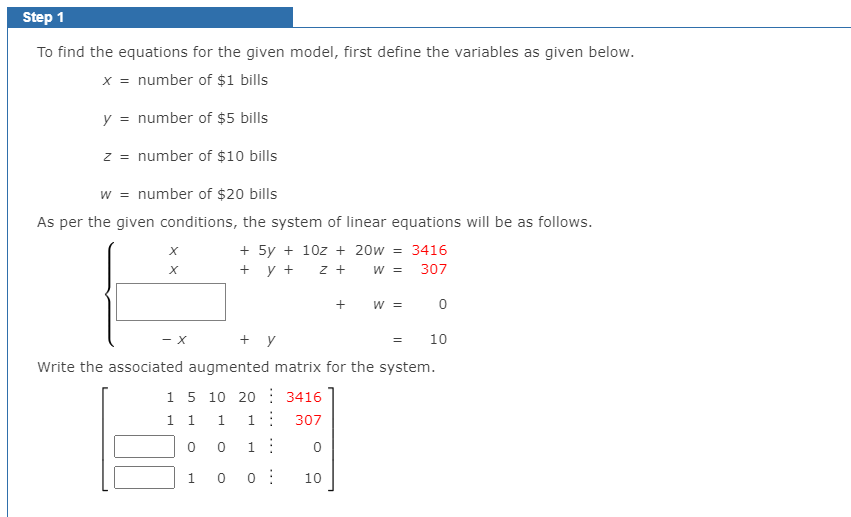Big Ideas Math A Bridge To Success Algebra 1: Student Edition 2015
1st Edition
ISBN:9781680331141
Author:HOUGHTON MIFFLIN HARCOURT
Publisher:HOUGHTON MIFFLIN HARCOURT
Chapter5: Solving Systems Of Linear Equations
Section5.4: Solving Special Systems Of Linear Equations
Problem 15Q
Related questions
Question

Transcribed Image Text:Step 1
To find the equations for the given model, first define the variables as given below.
x = number of $1 bills
y = number of $5 bills
z = number of $10 bills
w = number of $20 bills
As per the given conditions, the system of linear equations will be as follows.
+ 5y + 10z + 20w = 3416
+ y +
z +
W =
307
W =
- X
+ y
10
Write the associated augmented matrix for the system.
15 10 20 3416
1.
1
307
1:
1
0 0 :
10

Transcribed Image Text:A bank teller is counting the total amount of money in a cash drawer at the end of the shift. There is a total of
$3416 in denominations of $1, $5, $10, and $20 bills. The total number of paper bills is 307. The number of
$20 bills is twice the number of $1 bills, and the number of $5 bills is 10 more than the number of $1 bills.
Write a system of linear equations to represent the situation. Then use matrices to find the number of each
denomination.
Expert Solution
This question has been solved!
Explore an expertly crafted, step-by-step solution for a thorough understanding of key concepts.
Step by step
Solved in 2 steps

Knowledge Booster
Learn more about
Need a deep-dive on the concept behind this application? Look no further. Learn more about this topic, calculus and related others by exploring similar questions and additional content below.Recommended textbooks for you

Big Ideas Math A Bridge To Success Algebra 1: Stu…
Algebra
ISBN:
9781680331141
Author:
HOUGHTON MIFFLIN HARCOURT
Publisher:
Houghton Mifflin Harcourt

Glencoe Algebra 1, Student Edition, 9780079039897…
Algebra
ISBN:
9780079039897
Author:
Carter
Publisher:
McGraw Hill


Big Ideas Math A Bridge To Success Algebra 1: Stu…
Algebra
ISBN:
9781680331141
Author:
HOUGHTON MIFFLIN HARCOURT
Publisher:
Houghton Mifflin Harcourt

Glencoe Algebra 1, Student Edition, 9780079039897…
Algebra
ISBN:
9780079039897
Author:
Carter
Publisher:
McGraw Hill


Elementary Algebra
Algebra
ISBN:
9780998625713
Author:
Lynn Marecek, MaryAnne Anthony-Smith
Publisher:
OpenStax - Rice University

College Algebra (MindTap Course List)
Algebra
ISBN:
9781305652231
Author:
R. David Gustafson, Jeff Hughes
Publisher:
Cengage Learning
